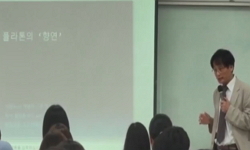In the middle eighth century the Roman Church had to do something to survive in the face of external pressures from three big powers, Byzantine Empire, Lombard Kingdom, and Frankish Kingdom, which competed with each other to gain the hegemony of Itali...
http://chineseinput.net/에서 pinyin(병음)방식으로 중국어를 변환할 수 있습니다.
변환된 중국어를 복사하여 사용하시면 됩니다.
- 中文 을 입력하시려면 zhongwen을 입력하시고 space를누르시면됩니다.
- 北京 을 입력하시려면 beijing을 입력하시고 space를 누르시면 됩니다.
부가정보
다국어 초록 (Multilingual Abstract)
In the middle eighth century the Roman Church had to do something to survive in the face of external pressures from three big powers, Byzantine Empire, Lombard Kingdom, and Frankish Kingdom, which competed with each other to gain the hegemony of Italian peninsula.
In the religious area, Pope Gregory Ⅱ, unlike his predecessors, decided to protest against Byzantine Emperors who have taken the initiative in the religious problems of the western Church until the early eighth century and presided all ecumenical councils solving the dogma problems to their own will. The Pope successfully showed his protest to the forcible demand of heavy taxation and iconoclasm to Italians. Successors of Gregory Ⅱ strengthened the resistance of Italians against the Emperors and raised up the problems as the common interests of the whole Italians. In the process of the struggle with the Emperors, the consciousness that Italia was a different national entity from the Byzantine Empire began to grow. The popes at last succeeded to hold fast to the tradition of the veneration of icons against iconoclasm of Byzantine Emperors, to distinguish the Roman Church from the Constantinople which destroyed icons, and so to lead the discriminated western Church.
In the political field, Popes also began to take the initiative through the politics of power-balance when they faced military threats from Lombard Kingdom. Popes, as representatives of Emperors, made a good use of Frankish Kingdom to remove the threats not to secure Emperors's interests but to establish his own political leadership and safety.
Hitherto many scholars have insisted that the popes continued to be loyal to the Byzantine Emperors until the middle eighth century. In my opinion, however, papal loyalty to the Emperors were liquidated in this period by their skillful tactics. The popes superficially acted as the representatives of the Emperors in Italian problems but they actually took an advantage of the office of the Byzantine Empire for the interest of the Roman Church. Adopting the politics of the balance of powers the popes could accomplish what they wanted for the Roman Church and establish what they looked for in western Europe, the foundation of temporal power that they will hold in the future. In short, all these prove that the popes of the mid-8th century displayed a distinguished leadership.
목차 (Table of Contents)
- 1. 머리말
- 2. 종교적 주도권
- 3. 정치적 주도권
- 4. 맺음말
- 〈Abstract〉
- 1. 머리말
- 2. 종교적 주도권
- 3. 정치적 주도권
- 4. 맺음말
- 〈Abstract〉
동일학술지(권/호) 다른 논문
-
- 호서사학회
- 김정화(kim Jung-Hwa)
- 2009
- KCI등재
-
- 호서사학회
- 조승래(Cho Seung-Rae)
- 2009
- KCI등재
-
- 호서사학회
- 한운석(Han Un-Suk)
- 2009
- KCI등재
-
- 호서사학회
- 조한욱(Cho Han-Ook)
- 2009
- KCI등재





 DBpia
DBpia


